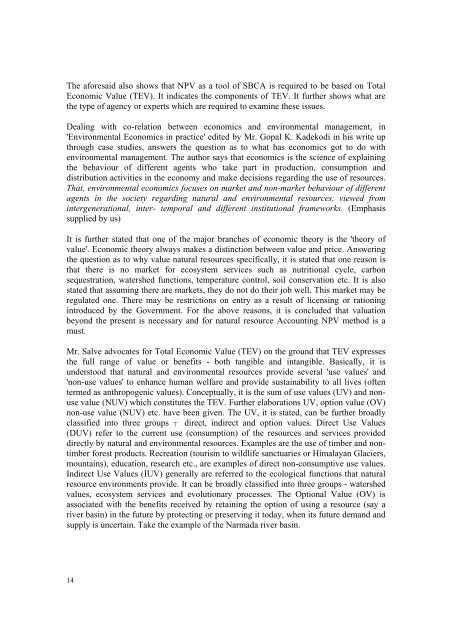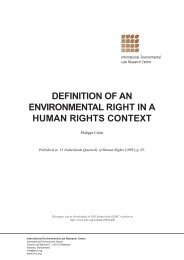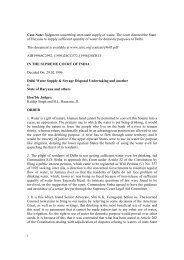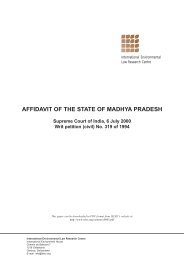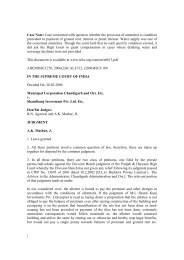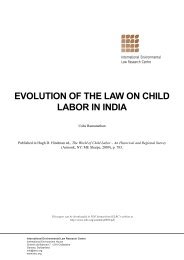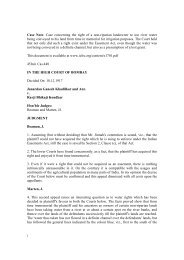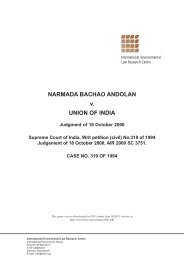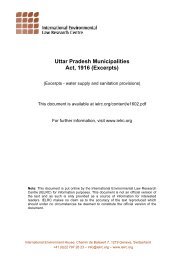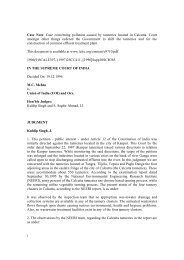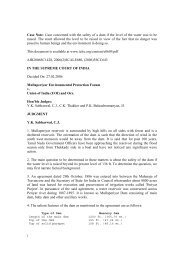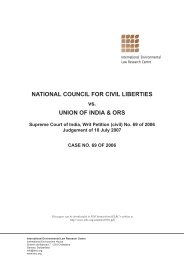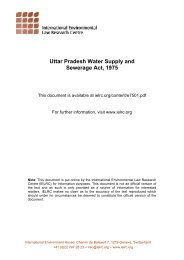The aforesaid also shows that NPV as a tool <strong>of</strong> SBCA is required to be based on TotalEconomic Value (TEV). It indicates the components <strong>of</strong> TEV. It further shows what arethe type <strong>of</strong> agency or experts which are required to examine these issues.Dealing with co-relation between economics and environmental management, in'Environmental Economics in practice' edited by Mr. Gopal K. Kadekodi in his write upthrough case studies, answers the question as to what has economics got to do withenvironmental management. The author says that economics is the science <strong>of</strong> explainingthe behaviour <strong>of</strong> different agents who take part in production, consumption anddistribution activities in the economy and make decisions regarding the use <strong>of</strong> resources.That, environmental economics focuses on market and non-market behaviour <strong>of</strong> differentagents in the society regarding natural and environmental resources, viewed fromintergenerational, inter- temporal and different institutional frameworks. (Emphasissupplied by us)It is further stated that one <strong>of</strong> the major branches <strong>of</strong> economic theory is the 'theory <strong>of</strong>value'. Economic theory always makes a distinction between value and price. Answeringthe question as to why value natural resources specifically, it is stated that one reason isthat there is no market for ecosystem services such as nutritional cycle, carbonsequestration, watershed functions, temperature control, soil conservation etc. It is alsostated that assuming there are markets, they do not do their job well. This market may beregulated one. There may be restrictions on entry as a result <strong>of</strong> licensing or rationingintroduced by the Government. For the above reasons, it is concluded that valuationbeyond the present is necessary and for natural resource Accounting NPV method is amust.Mr. Salve advocates for Total Economic Value (TEV) on the ground that TEV expressesthe full range <strong>of</strong> value or benefits - both tangible and intangible. Basically, it isunderstood that natural and environmental resources provide several 'use values' and'non-use values' to enhance human welfare and provide sustainability to all lives (<strong>of</strong>tentermed as anthropogenic values). Conceptually, it is the sum <strong>of</strong> use values (UV) and nonusevalue (NUV) which constitutes the TEV. Further elaborations UV, option value (OV)non-use value (NUV) etc. have been given. The UV, it is stated, can be further broadlyclassified into three groups direct, indirect and option values. Direct Use Values(DUV) refer to the current use (consumption) <strong>of</strong> the resources and services provideddirectly by natural and environmental resources. Examples are the use <strong>of</strong> timber and nontimberforest products. Recreation (tourism to wildlife sanctuaries or Himalayan Glaciers,mountains), education, research etc., are examples <strong>of</strong> direct non-consumptive use values.Indirect Use Values (IUV) generally are referred to the ecological functions that naturalresource environments provide. It can be broadly classified into three groups - watershedvalues, ecosystem services and evolutionary processes. The Optional Value (OV) isassociated with the benefits received by retaining the option <strong>of</strong> using a resource (say ariver basin) in the future by protecting or preserving it today, when its future demand andsupply is uncertain. Take the example <strong>of</strong> the Narmada river basin.14
It is not necessary to delve further in this matter since ultimately it would be for theexperts to examine and assist this Court as to the Model to be adopted for valuation,namely, TEV, CVM, SBCA etc. It is for the experts to tell us as to what NPV should beapplied in case <strong>of</strong> mines and different types <strong>of</strong> forests. We may only note that basis <strong>of</strong>these valuations is the theory <strong>of</strong> sustainable development, i.e., development that meets theneeds <strong>of</strong> the present without compromising with the ability <strong>of</strong> future generations to meettheir own needs. Despite various elaborations, definition <strong>of</strong> sustainable development,though very old, still is widely accepted world over and has been reiterated by this Courtin catena <strong>of</strong> cases.Regarding the parameters for valuation <strong>of</strong> loss <strong>of</strong> forest, we may only note as to what isstated by Ministry <strong>of</strong> Environment and Forests, Government in its handbook laying downguidelines and clarifications upto June 2004 while considering the grant <strong>of</strong> approvalunder Section 2 <strong>of</strong> the FC Act. Dealing with environmental losses (soil erosion, effect onhydrological cycle, wildlife habitat, microclimate upsetting <strong>of</strong> ecological balance), theguidelines provide that though technical judgment would be primarily applied indetermining the losses, as a thumb rule, the environmental value <strong>of</strong> one hectare <strong>of</strong> fullystocked forest (density 1.0) would be taken as Rs.126.74 lakhs to accrue over a period <strong>of</strong>50 years. The value will reduce with density, for example, if density is 0.4, the value willwork out at Rs.50.696 lakhs. So, if a project which requires deforestation <strong>of</strong> 1 hectare <strong>of</strong>forest <strong>of</strong> density 0.4 gives monetary returns worth over Rs.50.696 lakhs over a period <strong>of</strong>50 years, may be considered to give a positive cost benefit ratio. The figure <strong>of</strong> assumedenvironmental value will change if there is an increase in bank rate; the change will beproportional to percentage increase in the bank rate. Ms. Kanchan Chopra, whileconducting the case study <strong>of</strong> Keoladeo National Park in respect <strong>of</strong> economic valuation <strong>of</strong>biodiversity at the institute <strong>of</strong> economic growth, Delhi as a part <strong>of</strong> the Capacity 21 projectsponsored by the UNDP and MOEF, Government <strong>of</strong> <strong>India</strong> examined the question as towhat kind <strong>of</strong> values are to be taken into consideration. As per the study, differentcomponents <strong>of</strong> biodiversity system possess different kinds <strong>of</strong> value (1) a commodityvalue (as for instance the value <strong>of</strong> grass in a park), (2) an amenity value (the recreationvalue <strong>of</strong> the park) and/or (3) a moral value (the right <strong>of</strong> the flora and fauna <strong>of</strong> the park toexist). It is recognized that it is difficult to value ecosystem, since it possesses a largenumber <strong>of</strong> characteristic, more than just market oriented ones. It also leads to the need tocarry out bio-diversity valuation both in terms <strong>of</strong> its market linkage and the existencevalue outside the market as considered relevant by a set <strong>of</strong> pre-identified stakeholders. Itis, however, evident that while working out bio-diversity valuation, it is not trees and theleaves but is much more. Various techniques for valuing biodiversity that have beendeveloped to assess the value <strong>of</strong> living resources and habitats rich in such resources havebeen considered by the author for her case study while considering the aspect <strong>of</strong> value,their nature and stakeholders interest. In so far as the value <strong>of</strong> ecology function in whichthe stakeholders or scientists, tourists, village residents, non-users, the nature <strong>of</strong> value is -regulation <strong>of</strong> water, nutrient cycle, flood control. These instances have been noted tohighlight the importance <strong>of</strong> the biodiversity valuation to protect the environments. Theconclusions and the policy recommendations <strong>of</strong> the author are:15


